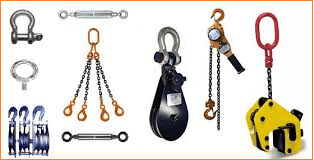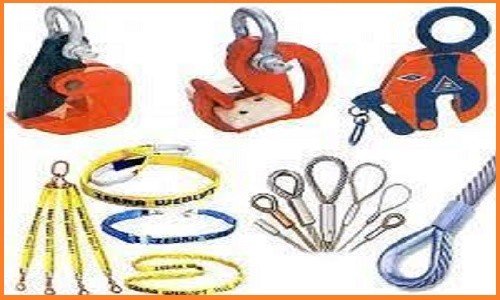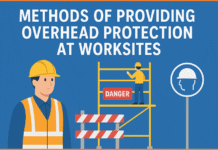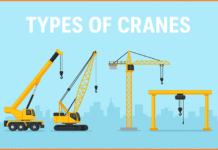The main requirements are as under:
- Section 29 of the Factories Act and Rule 60 of the Gujarat Factories Rules require that (1) All parts including the working gear, whether fixed or movable, shall be of good construction, sound material, adequate strength and free from defects, properly maintained and thoroughly examined by a competent person at least once in a year (2) A traveling crane should not be moved within 6 m of any person where he would be liable to be struck by the crane and (3) All rails and tracks shall be of proper size, adequate strength, even running surface, properly laid and maintained and adequately supported.
- A safe working load (SWL) and distinguishing or identification number should be marked on each lifting gear. A table of varying load and angle should be attached.
- Heat treatment of lifting gear should be carried out to remove defective structure developed during forging, welding or service and to improve the properties of the material i.e. to increase its strength, hardness, ductility, and toughness. Rule 60(5), GFR, requires annealing of parts in general use at least once in a year and that of the parts used to lift molten metal or slag or if made of less than 12.7 mm dia, once in 6 months.
- Chain sling should be selected as per the load requirement. Never decrease the angle between the legs of the chain sling and the horizontal. This increased load in the sling legs. Pad sharp corners. Lift without a jerk. Keep hands and fingers out of the chain and the load. Stand clear of the load when it is being lifted. Don’t lift beyond SWL and employ trained personnel.
- Wire rope is preferable than fiber rope due to its greater strength and durability, no change in physical characteristics and predictable stretch characteristics.
- There are five basic design elements of a wire rope: Grade of wire, Number, and pattern of wires in the strand, Type of lay, Performing and Type of core. Knowledge of these characteristics is useful in the selection of wire rope or wire rope slings.
- The diameter of the pulleys, reels, drums should be large to reduce bending action on the rope.

- Parts subjected to impact, wear and rough use should be of sufficient strength for its rated service. Bearing pressure of shafts should be within safe limits.
- Open hooks are unsafe. Spring lock at hook point and the guard on load block pulley rope are desirable. The heavy hook should have a handle to guide it for slings.
- Gantry cranes should have rail clamps, parking brakes, and wind velocity indicators and alarm.
- The rated load should be marked on each side of the crane and on each load block (hook assembly) in case of more hoisting units on one crane. The crane shall not be loaded beyond it’s rated capacity except for testing.
- Operating levers and control should be within reach of the operator. They should have spring return to move automatically to off position.
- Platforms, footwalks, steps, handholds, guard-rails, and toe guards shall be provided for safe walking and access ways. Platforms should have a non-slip surface. The step gap should not exceed 30 cm.
- Positive stops or limit switches shall be provided to prevent overrunning the safe limits. Lower and upper travel limit switches should be provided.
- Lubrication points shall be in a safe position.
- All gears, moving parts, couplings, and rope neaps should be totally enclosed.
- Traveling cranes should have powered and non-powered warning bells. Independent brakes for hoisting, traversing, travelling and parking operations.
- Sheaves and drums should be inspected for wear. Enlarged grooves indicate replacement.
- The rope end should be firmly anchored to the drum by a socket arrangement and a minimum of two turns (wraps) of rope should remain or the drum when the hook is at the lowest level.
- The rated load divided by the number of rope parts should be less than 20% of the nominal breaking strength of the rope.
- Power shall be shut off and personal padlock or tagging shall be provided before starting any repair or maintenance work. The arrangement should be made to prevent the entry of another crane in the zone of the crane under repair.
- DCP, CO2 or equivalent fire extinguisher should be kept in crane cabin.
Also, read this:
SAFETY IN HYDRA CARNE OPERATIONS






good EHS information material and please post some construction wealfear facilitys as per Indian standards.
What to check before entering any line or vessel entry in a chemical plant . Plz help me sir
Vessel Entry safety Procedure
Hii sir
my question is in the HIRA formates (action plan for futher control measure) what will be the target date and which date will be kept
plz can you suggested me plz
Send me